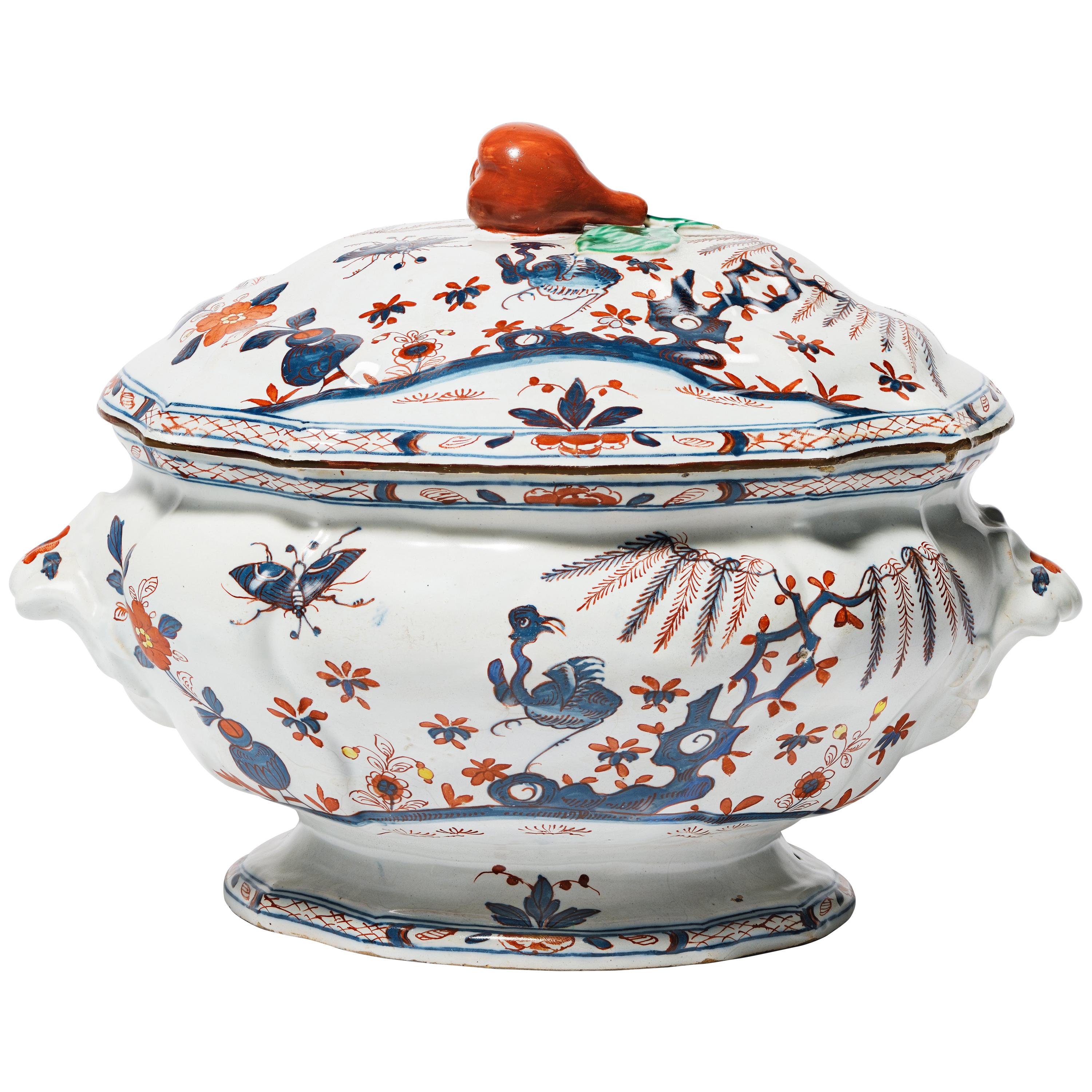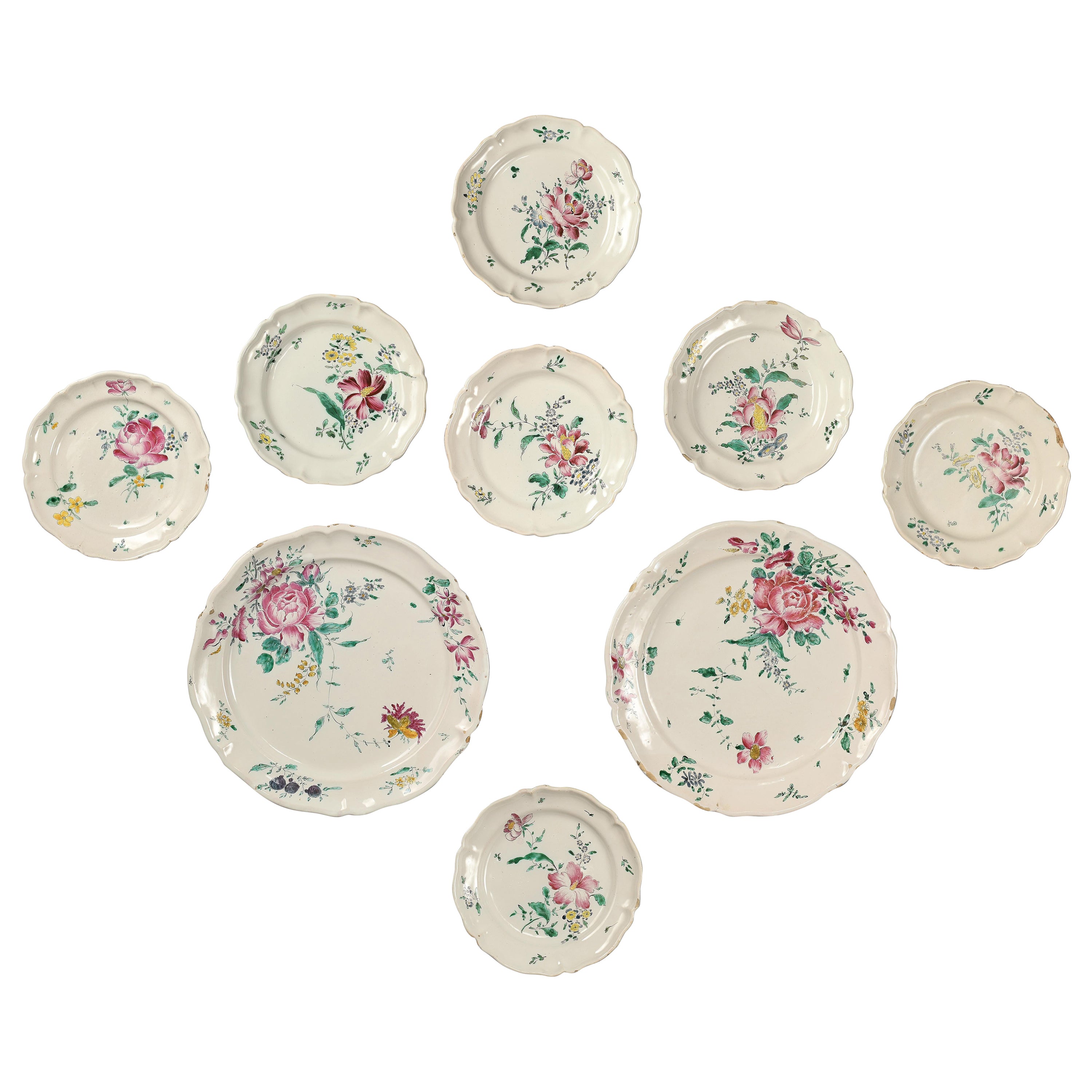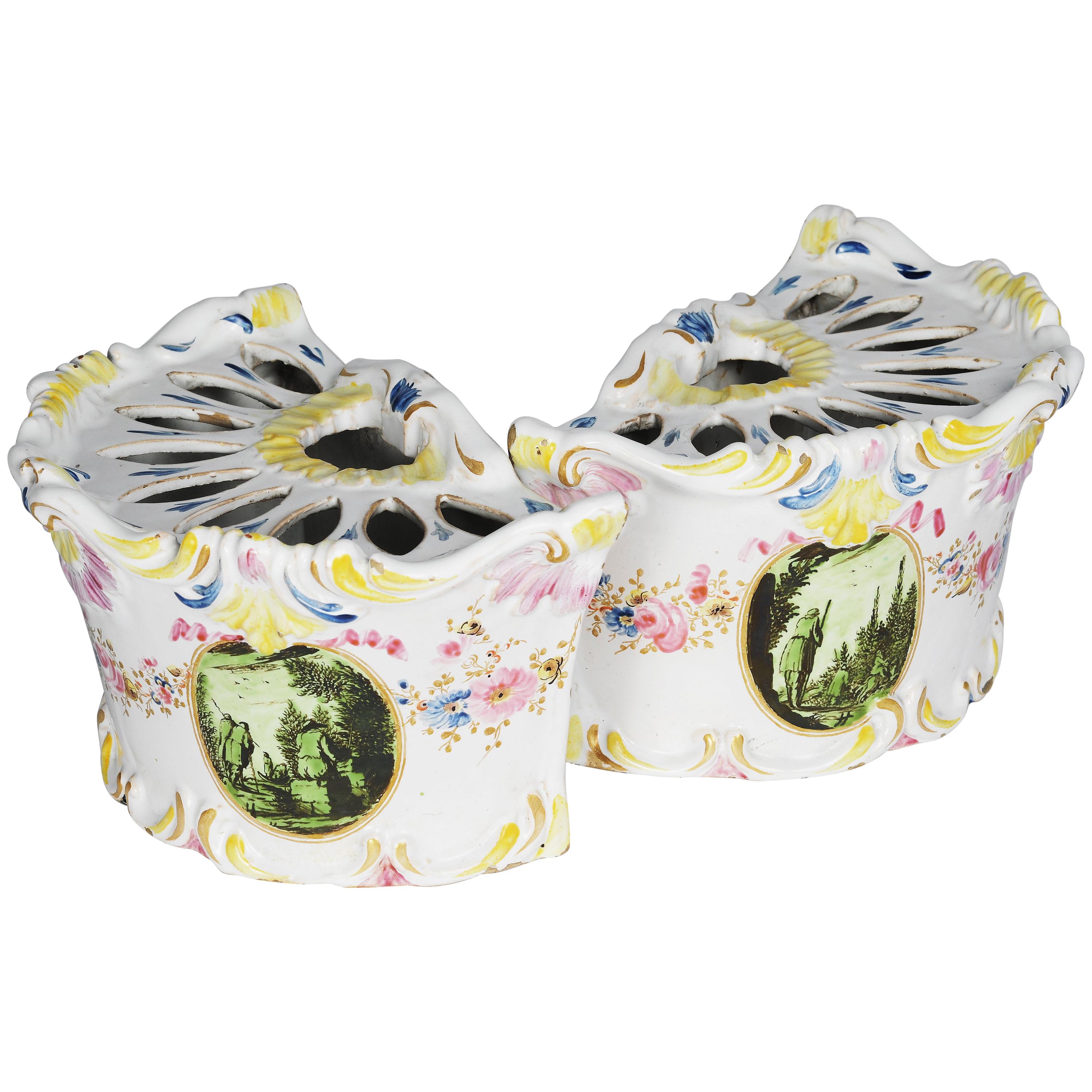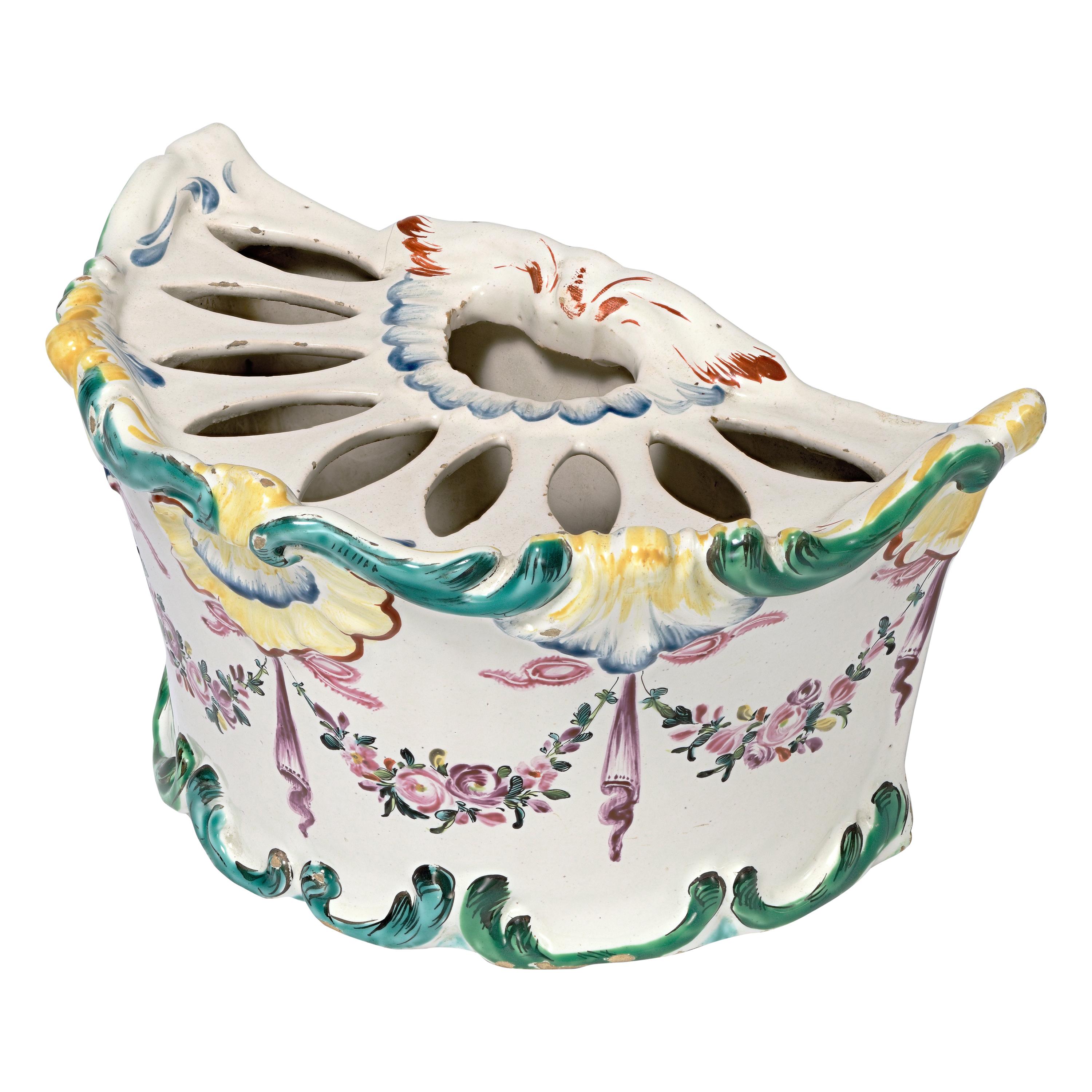Items Similar to Ancient Pair of Italian Maiolica Dishes Milano, circa 1770
Video Loading
Want more images or videos?
Request additional images or videos from the seller
1 of 17
Ancient Pair of Italian Maiolica Dishes Milano, circa 1770
About the Item
Two maiolica dishes, "Famille Rose" decoration
Felice Clerici Factory
Milan, 1770-1780
9.13 in (23.2 cm) each in diameter
lb 1.32 (kg 0.6)
State of conservation: perfect, except for slight chipping at the edges
The dishes are rare examples of a service produced by the factory of Felice Clerici (1710-1780) in Milan.
Felice Clerici had opened his own factory in Milan in 1745, inserting himself into the new European stylistic trend which saw maiolica becoming a fine product like porcelain. The Milanese entrepreneur worked in the early period with high fire furnaces, declaring only in 1759 that he had purchased "the secrets of the paintings by force of money," by which he meant he now could obtain colors with a greater chromatic range with a low fire.
The two dishes are funds with lightly blue glaze. Smooth barely detectable rim and ring foot. Along the edge there is a thin orange band with a chain of small spirals whereas along the brim there is a typical oriental decoration with peonies and chrysanthemums and minor florets. The flounce hosts a motif "in reserves" centered inside alternating flower and trellis motifs on pink and green backgrounds. In the center an oriental floral ornament is developed around a sturdy branch.
On the back the "fraction" brand by Felice Clerici in black.
Raffella Ausenda, while cataloging a maiolica in the same model as ours, conserved in the collections of the Museo di Arti Applicate del Castello in Milan (to which we refer for comparison), highlights that the ornamentation is directly inspired by Chinese porcelain from the Kang'hsi period known as "Famille Rose". The Clerici manufacture had in fact such a technical command of colors that it could perfectly imitate the oriental models even thanks to the aid of painters such as Giuseppe Sormani and Giacomo Facchetti who “painted with enamel in gold and silver colors. They imitate and accompany porcelain".
The recent publication, edited by the same scholar (R. Ausenda in J.V.G. Mallet and E.P. Sani, a cura di, Maiolica in Italy and Beyond. pp. 124-140), underlines how the rebirth of maiolica in northern Italy also sprang from the experiences of the Milanese factory of Pasquale Rubati. This factory, established in 1756, obtained very high quality products, even considered among the best of the time. In the study she remarks how the pieces produced in the factory so closely matched Chinese porcelain that they were often used to replace pieces needing substitution, as Rubati himself declares "... to be able to accompany the missing pieces of porcelain with maiolica without distinguishing one on the other hand, except transparency. " (R. Ausenda in J.V.G. Mallet and E.P. Sani, a cura di, Maiolica in Italy and Beyond,. pp. 124 140)
Many examples for comparison are kept in the main European museum collections including a famous tureen that bears the coat of arms of the Marquis Don Giovanni Olivera. This leads us to a certain chronological collocation of 1771, the year the emblem was registered in the Teresian heraldic codes. (Ausenda, R., a cura di, Musei e Gallerie di Milano. Museo d’Arti Applicate. Le ceramiche. Tomo secondo. Milano 2001, pp. 349, n. 335 and related bibliography). The tureen is kept in the Kunst und Gewerbe Museum in Hamburg (inv. 1882.276).
From the same De Olivera service comes a dish which was purchased from our gallery by MUDEC (Museum of Cultures of Milan) and which is currently exhibited as a work in the permanent collections of the exhibition Milano globale, il Mondo visto da qui (Global Milan, the World Seen from Here).
Bibliography:
R. Ausenda, a cura di, Musei e Gallerie di Milano. Museo d’Arti Applicate. Le ceramiche. Tomo secondo. Milano 2001, pp. 349, n. 335 e bibliografia relativa.
R. Ausenda, Hig-quality Maiolica in the Style of Porcellain: Experiments in northern Italian Maiolica in its productive final Years in J.V.G. Mallet and E.P. Sani, a cura di, Maiolica in Italy and Beyond,. pp. 124 140
R. Ausenda in, Milano globale, il Mondo visto da qui, sala 2 la nuova dimensione globale del continente asiatico pp. 194-195.
- Creator:Felice Clerici (Manufacturer)
- Dimensions:Height: 1.11 in (2.8 cm)Diameter: 9.14 in (23.2 cm)
- Sold As:Set of 2
- Style:Rococo (Of the Period)
- Materials and Techniques:Maiolica,Other
- Place of Origin:
- Period:1770-1779
- Date of Manufacture:circa 1770
- Condition:Wear consistent with age and use. Almost perfect, except for slight chipping at the edges.
- Seller Location:Milano, IT
- Reference Number:1stDibs: LU4352214025232
About the Seller
4.3
Vetted Seller
These experienced sellers undergo a comprehensive evaluation by our team of in-house experts.
Established in 1860
1stDibs seller since 2018
19 sales on 1stDibs
Typical response time: 4 hours
Associations
International Confederation of Art and Antique Dealers' Associations
- ShippingRetrieving quote...Ships From: Milano, Italy
- Return PolicyA return for this item may be initiated within 14 days of delivery.
More From This SellerView All
- Ancient Italian Maiolica Tureen Milano, 1770 circaBy Felice Clerici, Pasquale RubatiLocated in Milano, ITMaiolica tureen “allo struzzo” (ostrich decoration) Milan, Felice Clerici or Pasquale Rubati factory, circa 1750-1780 Measures: 9.25 in x 12.79 in x 10.23 in (cm 23.5 x cm 32.5 x cm 26) lb 4.78 (kg 2.17) State of conservation, a felûre consolidated inside with slight edge chipping restored. In Milan in the 18th century two Majolica warehouses were opened, the first, by Felice Clerici, in 1745, the second in 1756 by Pasquale Rubati. Traditionally this type of decoration has been attributed to the Pasquale Rubati factory. In reality the motif “allo struzzo”, one of the clearest examples of how the taste for chinoiserie met with considerable success during the 18th century, had been produced, in specimens of greater or lesser quality, by both Milanese manufactories. This Maiolica tureen has a swollen and ribbed oval bowl, rests on an extroflexed foot and shows stirrup handles. The tri-color ornament, in the typical tones of Japanese "Imari" decorations, shows an idealized oriental landscape that develops around a perforated rock and has a willow tree with long lance-shaped leaves framing the long-legged bird figure. The ornamentation is enhanced by decorative elements such as butterflies, small florets and a vase with a thin flowery stem. The lid is ribbed with a pear-shaped knob on top. The decoration was called in the Milanese manufactories "allo struzzo" (ostrich decoration) and this refers to the oriental figure Xian He or the crane, symbol of longevity, here losing its symbolic value. It is hypothesized that among some 16th century engravings...Category
Antique 1770s Italian Chinoiserie Ceramics
MaterialsMaiolica
- Ancient Italian Maiolica Rose Dishes by Pasquale Rubati Milano, 1780 circaBy Pasquale RubatiLocated in Milano, ITAssortment of 12 elements with polychrome and gold decoration Pasquale Rubati Factory Milan, circa 1770- 1790. Two oval trays 10.62 in x 8.58 in (27 x 21.8 cm) Two dishes with perf...Category
Antique 1770s Italian Rococo Ceramics
MaterialsMaiolica
- Ancient Maiolica Dishes with flowers, Lombard Manufacture, 1770-1780 CircaLocated in Milano, ITAssortment of dishes Lombard manufacture 1770 – 1780 Circa Maiolica polychrome decorated “a piccolo fuoco” (third fire). Two large dishes: diameter 14.76 in (37.5 cm); weight 4.5...Category
Antique 1770s Italian Rococo Ceramics
MaterialsMaiolica
- 18th Century Italian Maiolica Dish Milano, circa 1770Located in Milano, ITMaiolica dish, "Famille Rose" and gold decoration Felice Clerici factory Milan, 1770-1780 8.93 in (22.27 cm) in diameter lb 0.66 (kg 0.3) State of conservation: perfect, except for ...Category
Antique 1770s Italian Rococo Ceramics
MaterialsMaiolica
- Pair of Ancient Italian Maiolica Flower Pots Milan, Rubati Factory, 1770 circaBy Pasquale RubatiLocated in Milano, ITMaiolica flower pot “a mezzaluna” decorated with trompe l’oeil Pasquale Rubati Factory Milan, circa 1770 Measures: each 4.7 in (cm 12) x 5 in (c...Category
Antique 1770s Italian Rococo Ceramics
MaterialsMaiolica
- Italian Maiolica Flower Pot Garlands of Flowers, P. Rubati, Milano, 1770 circaBy Pasquale RubatiLocated in Milano, ITMaiolica flower pot “a mezzaluna” decorated with garlands of flowers Pasquale Rubati Factory Milan, circa 1770 Measures: 4.7 in x 5 in x 8.8 in ...Category
Antique 1770s Italian Rococo Ceramics
MaterialsMaiolica
You May Also Like
- Pair of Italian Maiolica Vases, Coiled Snake Handles, Ca. 1880By CapodimonteLocated in Banner Elk, NCPair of Italian Maiolica Vases, of baluster form, with polychrome Renassance style decptions, on pedestal bases, with large molded and applied snakes forming the handles, the reverse...Category
Antique Late 19th Century Italian Renaissance Revival Ceramics
MaterialsMaiolica
- Pair of Hand Painted Freeform Dishes, Italy, 1950'sLocated in Barcelona, ESA pair of Italian free form dishes from 1950's signed Man. Hand painted glazed ceramic. They can be used as a dish or tray or as wall decoration.Category
Vintage 1950s Italian Mid-Century Modern Decorative Art
MaterialsCeramic
- Pair of Italian Maiolica Chargers Depicting Roman Warriors in CombatLocated in San Francisco, CAA near pair of Italian maiolica plates depicting battle scenes of Roman soldiers one with garrisons on horseback the other possibly an allegorical tale of the assassination of a Roma...Category
Early 20th Century Italian Ceramics
MaterialsEarthenware
- Turquoise Maiolica Italian Albarello Late, 1800sLocated in Roma, ITThis beautiful turquoise maiolica patterned Italian albarello (late 1800s early 1900s) was found in Palazzo Torlogna in Rome. Albarelli were ancient storag...Category
Antique Early 19th Century Italian Greco Roman Ceramics
MaterialsMaiolica, Ceramic
- Pair of Barbotine Ceramic Dishes, Art Nouveau Period, France, circa 1890By BarbotineLocated in Buenos Aires, Buenos AiresPair of Barbotine ceramic dishes, Art Nouveau Period, France, circa 1890.Category
Antique 1890s French Art Nouveau Ceramics
MaterialsCeramic
- Pair of French Rococo Style Sweet DishesLocated in Chillerton, Isle of WightPair of French Rococo style sweet Dishes A very attractive pair of sweet dishes one with a handle, the other with a lid the dishes have a slightly crazed finish with simulated orm...Category
Late 20th Century Baroque Revival Ceramics
MaterialsCeramic
Recently Viewed
View AllMore Ways To Browse
Italian Silver 18th Century
Antique Dishes Glass
Italian Fine Ceramics
Pair Glass Dishes
Italian 1770
Green Glass Ring
Pair Silver Painting
Coat Of Arms Italian
Italian Coat Of Arms
Used Dishes China
Oriental Ceramics
18th Century Firing Glass
Pair Of Coat Of Arms
Coat Of Arms Pair
Rococo 1770
Small Silver Dishes
Rococo Pink
Used China Dishes





